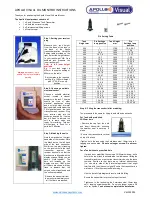
18
English
2179604
*2179604*
Having the product checked by
Hilti
Measuring Systems Service does not relieve the user of his/her
obligation to check the product before and during use.
7.3
Checking accuracy
In order to ensure compliance with the technical specifications, the tool should be checked regularly (at least
before each major / relevant measuring task).
After falling from considerable height, the tool should be checked for correct, accurate operation. When the
following conditions are fulfilled it can be assumed that the tool is operating faultlessly:
• The height of the fall did not exceed the height given in the technical data.
• The tool operated faultlessly before the impact.
• The tool suffered no obvious mechanical damage from the impact (e.g. breakage of the pentaprism).
• The tool projects a rotating laser beam when in operation.
7.4
Checking the main and transverse horizontal axes
1. Set up the tripod approx. 20 m (66ft) from a wall and level the tripod head with the spirit level.
2. Mount the device tool on the tripod and use the visual sighting method (front and rear sights) to aim the
tool at the wall.
3. Fig. a: Use the receiver to catch the laser beam and mark a point (point 1) on the wall.
4. Pivot the device clockwise through 90° about its own axis. In doing so, make sure that the height of the
device does not change.
5. Fig. b: Use the laser receiver to catch the laser beam and mark a second point (point 2) on the wall.
6. Figs. c and d: Repeat the two previous steps twice and use the laser receiver to catch the beam and
mark points 3 and 4 on the wall.
If the procedure has been carried out accurately, the vertical distance between the two marked
points 1 and 3 (main axis) and between points 2 and 4 (transverse axis) should each be <2 mm (at 20
m) (0.08" at 66 ft). If the deviation is greater than this, return the device to
Hilti
Service for calibration.
7.5
Checking the vertical axis
1. Place the device in the vertical position on a floor that is as flat as possible, approx. 1 to 10 m (3 - 33 ft)
from a wall.
2. Align the grips parallel with the wall.
3. Switch on the device and mark the reference point (R) on the floor.
4. With the aid of the receiver, mark point (A) at the base of the wall.
5. With the aid of the receiver, mark point (B) at a height of approx. 10 m (33 ft).
6. Pivot the device through 180° and realign it with the reference point (R) on the floor and with point (A) at
the base of the wall. This can also be done using the automatic alignment function.
7. Bring the vertical laser plane into alignment automatically. → page 10
8. With the aid of the receiver, mark point (C) at a height of approx. 10 m (33 ft).
▶
When this procedure is carried out carefully, the horizontal distance between the two marked points
(B) and (C) should be < 2 mm (at 10 m) (0.08 inch at 33 ft). If the deviation is greater than this, return
the device to
Hilti
Service for calibration.
8
Transport and storage
8.1
Transport and storage of cordless tools
Transport
CAUTION
Accidental starting during transport
!
▶
Always transport your products with the batteries removed!
▶
Remove the battery.
▶
Never transport batteries in bulk form (loose, unprotected).
▶
Check the tool and batteries for damage before use after long periods of transport.
Summary of Contents for PR 30-HVSG
Page 1: ...PR 30 HVSG English 1 Français 21 Español 42 Português 63 ...
Page 2: ...1 ...
Page 3: ...2 3 4 5 ...
Page 4: ...6 7 8 9 ...
Page 5: ...10 11 12 13 ...
Page 6: ...14 15 ...
Page 7: ...16 17 ...
Page 93: ... 2179604 2179604 Português 85 ...
Page 94: ...86 Português 2179604 2179604 ...
Page 95: ... 2179604 2179604 Português 87 ...
Page 96: ...Hilti registered trademark of Hilti Corp Schaan Pos 2 20200213 2179604 2179604 ...
















































